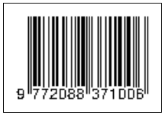Analisis Unjuk Kerja K-Nearest Neighbour untuk Klasifikasi Citra Aksara Bali Tulis Tangan
Anastasia Rita Widiarti(1*), Hari Suparwito(2)
(1) Fakultas Sains dan Teknologi, Universitas Sanata Dharma, Yogyakarta
(2) Fakultas Sains dan Teknologi, Universitas Sanata Dharma, Yogyakarta
(*) Corresponding Author
Abstract
A lack of philologists and the vulnerability of palm leaf material have become triggers for the scripting automation or transliteration of Balinese script images on computer-assisted palm leaves. One possibility to solve this problem is to create a transliteration machine. We proposed a machine learning technique using the k-NN algorithm to create a transliteration of Balinese script images. The benefit of the kNN algorithm is simply working by matching the similarity of new data to the nearest test data.
Instead of focusing on the classification technique, the study approaches also analyze the two previous processes: the first process is an image preparation process consisting of binarization, cutting the blanks, equalizing size, and thinning. The second is a feature extraction process using the character intensity algorithm. Our experiment employed 18 classes representing 18 Balinese characters.
The optimal accuracy using a 3-fold cross-validation method to 1001 image data yields an average of accuracy is 84.746%. Although the image data used is handwritten, however, kNN algorithm performed classification well using an extensive training dataset. For that reason, the kNN algorithm could be potential for Balinese script images transliteration.
Keywords
Full Text:
PDFReferences
M. Sudarma and I. W. A. S. Darma, "The Identification of Balinese Scripts’ Characters based on Semantic Feature and K Nearest Neighbor," International Journal of Computer Applications, pp. 14-18, April 2014.
I. W. A. S. Darma and N. K. Ariasih, "Handwritten Balinesse Character Recognition using K-Nearest Neighbor," in The 2nd ICCT International Conference on Culture Technology, Japan, 2017.
I. W. A. S. Darma, "Implementation of Zoning and K-Nearest Neighbors in Character Recognition of Wrésastra Script," Lontar Komputer, vol. 10, no. 1, pp. 9-18, April 2019.
I. A. D. P. Sari, B. Hidayat and U. Sunarya, "Pengenalan Aksara Bali Dengan Metode Local Binary Pattern," in Engineering, 2015.
F. Sthevanie, I. P. I. Aristya and K. N. Ramadhani, "Pengenalan Aksara Bali Menggunakan Metode Pyramid Histogram of Oriented Gradients," Ind. Journal on Computing, vol. 5, no. 1, pp. 73-84, 2020.
G. G. Rajput and S. B. Ummapure, "Script identification from handwritten documents using SIFT method," in 2017 IEEE International Conference on Power, Control, Signals and Instrumentation Engineering (ICPCSI), Chennai, India, 2017.
S. B. Ahmed, S. Naz, M. I. Razzak and T. M. Breuel, "Balinese Character Recognition Using Bidirectional LSTM Classifier," in International Conference on Machine learning and Signal Processing (MALSIP) , Ho Chi Minh, 2015.
A. R. Widiarti and K. Pinaryanto, "Segmentasi Citra Huruf Daun Lontar. Laporan Penelitian.," Lembaga Penelitian dan Pengabdian pada Masyarakat, Yogyakarta, 2019.
A. R. Widiarti and C. K. Adi, "Clustering Citra Aksara Bali Hasil Segmentasi Citra Daun Lontar. Laporan Penelitian Hibah Penelitian Internal Reguler.," Lembaga Penelitian dan Pengabdian pada Masyarakat, Yogyakarta, 2019.
X. Wu, S. Wang and L. Zhang, "The theory and application of k-nearest neighbor algorithm," Computer engineering and Application, vol. 53, no. 21, 2017.
V. Khan and Y. Sharma., "Performance Analysis Of K-Nearest Neighbours Algorithms For Automatic Handwritten Devanagari Text Generation In Marathi Styles," Journal Of Critical Reviews, vol. 7, no. 14, pp. 802-814, 2020.
Article Metrics
Refbacks
- There are currently no refbacks.
Copyright (c) 2022 IJEIS (Indonesian Journal of Electronics and Instrumentation Systems)

This work is licensed under a Creative Commons Attribution-ShareAlike 4.0 International License.
View My Stats1







